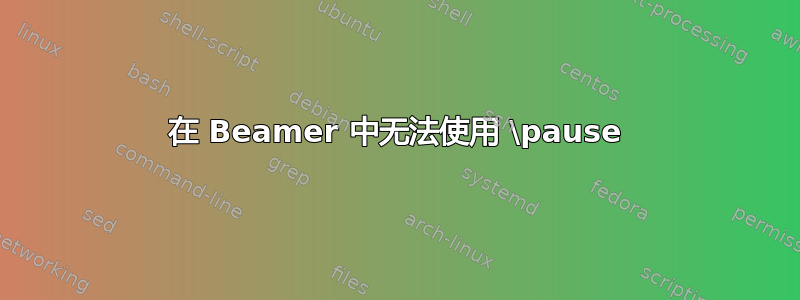
我尝试使用\pauseBeamer 中的命令,但它只能使它们变得不可见,按下 Shift 键后没有其他任何内容出现。
这是我的代码:
\documentclass[compress,xcolor=dvipsnames,slidestop]{beamer}
\usepackage{graphicx}
\usepackage{mathrsfs}
\usepackage{multicol}
\usepackage{tikz}
\usepackage{bm}
\usepackage{color}
\usepackage{soul}
\usepackage{comment}
\allowdisplaybreaks
\makeatletter
\newenvironment<>{proofs}[1][\proofname]{\par\def\insertproofname{#1\@addpunct{.}}\usebeamertemplate{proof begin}#2}{\usebeamertemplate{proof end}}
\makeatother
\newcommand*{\theorembreak}{\usebeamertemplate{theorem end}\framebreak\usebeamertemplate{theorem begin}}
\setbeamertemplate{theorem begin}
{%
\par\vskip\medskipamount%
\begin{beamercolorbox}[colsep*=.75ex]{block title}
\usebeamerfont*{block title}%
\inserttheoremname
\ifx\inserttheoremaddition\empty\else\ (\inserttheoremaddition)\fi%
\end{beamercolorbox}%
{\parskip0pt\par}%
\ifbeamercolorempty[bg]{block title}
{}
{\ifbeamercolorempty[bg]{block body}{}{\nointerlineskip\vskip-0.5pt}}%
\usebeamerfont{block body}%
\vskip-.25ex\vbox{}%
}
\setbeamertemplate{theorem end}{}
%\newcommand{\hyp}[5]{\,\mbox{}_{#1}F_{#2}\!\left(
% \genfrac{}{}{0pt}{}{#3}{#4};#5\right)}
%\newcommand{\qhyp}[5]{\,\mbox{}_{#1}\phi_{#2}\!\left(
% \genfrac{}{}{0pt}{}{#3}{#4};#5\right)}
%\newcommand{\topt}[2]{\left\{\substack{{#1}\\{#2}}\right\}}
%\newcommand{\tops}[3]{\left\{\substack{{#1}\\{#2}\\{#3}}\right\}}
\def\dd{\mathrm{d}}
\def\del{\partial}
\def\cA{\mathbf{A}}
\def\cB{\mathbf{B}}
\def\cC{\mathbf{C}}
\def\cD{\mathbf{D}}
\def\cP{\mathcal{P}}
\def\cS{\mathcal{S}}
\def\mcI{\mathcal{I}}
\def\mcJ{\mathcal{J}}
\def\mcG{\mathcal{G}}
\def\mcS{\mathcal{S}}
\def\mcH{\mathcal{H}}
\def\cM{\mathcal{M}}
\def\cO{\mathcal{O}}
\def\eps{\epsilon}
\def\Lie{\mathscr L}
\def\bL{\mathbf L}
\DeclareMathOperator{\sech}{sech}
\DeclareMathOperator{\li}{Li}
\newcommand{\rmd}{\mathrm}
\newcommand{\disp}{\displaystyle}
\newcommand{\zp}{\zeta^{\prime}}
\newcommand{\Glaisher}{\textbf{A}}
\newcommand{\G}{\textbf{\textup{G}}}
\newcommand{\Beta}{\mathrm{B}}
%\newcommand{\wbfx}{\widehat{\bf x}}
%\newcommand{\wbfxp}{\widehat{\bf x}^\prime}
\newcommand{\bfx}{{\bf x}}
\newcommand{\bfy}{{\bf y}}
\newcommand{\bfxp}{{{\bf x}^\prime}}
%\newcommand{\N}{{\mathbf N}}
\newcommand{\M}{{\mathbf M}}
\newcommand{\Q}{{\mathbf Q}}
%\newcommand{\R}{{\mathbf R}}
\newcommand{\Hi}{{\mathbf H}}
\newcommand{\Si}{{\mathbf S}}
\newcommand{\h}{{\mathfrak h}}
\newcommand{\g}{{\mathfrak g}}
\newcommand{\E}{{\mathbf E}}
%\newcommand{\Z}{{\mathbf Z}}
%\newcommand{\C}{{\mathbf C}}
\newcommand{\Ei}{\mbox{Ei}}
\newcommand{\Ci}{\mbox{Ci}}
\newcommand{\ci}{\mbox{ci}}
\newcommand{\RR}{{\mathsf R}}
\newcommand{\cg}{{\cal G}}
\newcommand{\Ni}{{\bf N}}
%\newcommand{\Ri}{{\bf R}}
%%%% roberto inserted
\definecolor{Mycolor2}{HTML}{e85d04}
\sethlcolor{black}
\newcommand\moro[1]{{\textcolor{blue}{#1}}} %% original notes
\newcommand\rcoro[1]{{\textcolor{Mycolor2}{\newline
\bf[RCS: {#1}]\newline}}} %% Rob comments
\newcommand\noro[1]{{\textcolor{red}{#1}}}
\newcommand\goro[1]{{\textcolor{gray!60!green}{#1}}} %% rob reviewed comments
\newcommand\koro[1]{{\textcolor{gray}{\bf #1}}} %% rob reviewed comments
\newcommand\poro[1]{{\textcolor{purple}{#1}}}
\newcommand\doro[1]{{\textcolor{darkgray}{#1}}}
\newcommand\boro[1]{{\textcolor{black}{#1}}}
%%%% final roberto
\newcommand{\BL}[7]{\ensuremath{%
\underset{#2}{\overset{#3}{\left#1\vphantom{#7}\right.}}
#7
\underset{#5}{\overset{#6}{\left.\vphantom{#7}\right#4}}
}}
\newcommand{\bl}[2]{\ensuremath{%
\underset{\,}{\overset{#1}{\left\llbracket\vphantom{#2}\right.}}
#2
\underset{\,}{\overset{\,}{\left.\vphantom{#2}\right\rrbracket}}
}}
%\newcommand{\II}[1]{\ensuremath{%
%\underset{\,}{\overset{#1}{{\Huge\left\rrbracket\!\!\llbracket}\vphantom{.}\right.}
%}
%\newcommand{\III}[2]{\ensuremath{%
%\underset{\,}{\overset{#1}{\left{\mathlarger{\mathlarger{\mathlarger{\rrbracket\!%\!\llbracket}}}}\vphantom{#2}\right.}\!\!}
%#2
%\underset{\,}{\overset{\,}{%\left.
%\vphantom{#2}
%%\right\rrbracket
%}}
%}}
\newcommand{\II}[1]{\overset{\raisebox{0.5ex}{$#1$}}{\raisebox{-0.55cm}{\resizebox{0.3cm}{!}{\scalebox{0.4}[1.0]{\mbox{$\mathbb{I}$}}}}}}
%\newcommand{\IIII}[3]{\ensuremath{%
%\underset{#1}{\overset{#2}{\left{\mathlarger{\mathlarger{\mathlarger{\rrbracket\!%\!\llbracket}}}}\vphantom{#3}\right.}\!\!}
%#3
%\underset{\,}{\overset{\,}{%\left.
%\vphantom{#3}
%%\right\rrbracket
%%}}
%}}
%Van de Bult Rains macros
\newcommand{\rphis}[2]{{}_{#1\vphantom{#2}}\phi_{#2\vphantom{#1}}}
\newcommand{\rWs}[2]{{}_{#1\vphantom{#2}}W_{#2\vphantom{#1}}}
\newcommand{\rWsn}[3]{{}_{#1\vphantom{#2}}^{\vphantom{(#3)}}W_{#2\vphantom{#1}}^{(#3)}}
\newcommand{\rphisx}[4]{\rphis{#1}{#2}\left( \begin{array}{c} #3 \end{array};q,#4\right)}
\newcommand{\hyp}[5]{\,\mbox{}_{#1}F_{#2}\!\left(
\genfrac{}{}{0pt}{}{#3}{#4};#5\right)}
\newcommand{\Ohyp}[5]{\,\mbox{}_{#1}{\bm{F}}_{#2}\!\left(
\genfrac{}{}{0pt}{}{#3}{#4};#5\right)}
\newcommand{\Whyp}[5]{\,\mbox{}_{#1}W_{#2}\!\left({#3};{#4};{#5}\right)}
\newcommand{\qhyp}[5]{\,\mbox{}_{#1}\phi_{#2}\!\left(
\genfrac{}{}{0pt}{}{#3}{#4};#5\right)}
\newcommand{\qphyp}[6]{\,{}_{#1}\phi_{#2}^{#3}\!\left(
\genfrac{}{}{0pt}{}{#4}{#5};#6\right)}
%\newcommand{\qPhihyp}[5]{\Phi{}_{#1}^{#2}\!\left[
%\genfrac{}{}{0pt}{}{#3}{#4};#5\right]}
\newcommand{\Kampe}[5]{F_{#1}^{#2}\!\left[
\genfrac{}{}{0pt}{}{#3}{#4};#5\right]}
\newcommand{\topt}[2]{\left\{\substack{{#1}\\[0.02cm]{#2}}\right\}}
\newcommand{\tops}[3]{\left\{\substack{{#1}\\{#2}\\{#3}}\right\}}
\newcommand{\topr}[4]{\left\{\substack{{#1}\\{#2}\\{#3}\\{#4}}\right\}}
\newcommand{\topq}[5]{\left\{\substack{{#1}\\{#2}\\{#3}\\{#4}\\{#5}}\right\}}
\newcommand{\topp}[6]{\left\{\substack{{#1}\\{#2}\\{#3}\\{#4}\\{#5}\\{#6}}\right\}}
\newcommand{\pFq}[5]{ {{}_{#1}F_{#2}}\left( \genfrac..{0pt}{}{#3}{#4};#5\right)}
\newcommand{\pPq}[6]{ {{}_{#1}\phi_{#2}}\left( \genfrac..{0pt}{}{#3}{#4};#5,#6\right)}
\newcommand{\qbinom}[3]{\biggl[\genfrac..{0pt}{}{#1}{#2} \biggr]_{#3} }
\newcommand{\kampeF}[9]{ {{}F^{#1}_{#2}}\left( \genfrac..{0pt}{}{#3: #4;#5}{#6: #7; #8};#9\right)}
\newcommand{\doubleH}[9]{ {{}H^{#1}_{#2}}\left( \genfrac..{0pt}{}{#3: #4: #5}{#6: #7: #8};#9\right)}
\newtheorem{thm}{Theorem}[section]
\newtheorem{cor}[thm]{Corollary}
\newtheorem{con}[thm]{Conjecture}
\newtheorem{rem}[thm]{Remark}
\newtheorem{res}[thm]{Result}
\newtheorem{lem}[thm]{Lemma}
\newtheorem{defn}[thm]{Definition}
\newtheorem{prop}[thm]{Proposition}
\makeatletter
\def\eqnarray{\stepcounter{equation}\let\@currentlabel=\theequation
\global\@eqnswtrue
\tabskip\@centering\let\\=\@eqncr
$$\halign to \displaywidth\bgroup\hfil\global\@eqcnt\z@
$\displaystyle\tabskip\z@{##}$&\global\@eqcnt\@ne
\hfil$\displaystyle{{}##{}}$\hfil
&\global\@eqcnt\tw@ $\displaystyle{##}$\hfil
\tabskip\@centering&\llap{##}\tabskip\z@\cr}
\def\endeqnarray{\@@eqncr\egroup
\global\advance\c@equation\m@ne$$\global\@ignoretrue}
\def\@yeqncr{\@ifnextchar [{\@xeqncr}{\@xeqncr[5pt]}}
\makeatother
\parskip=0pt
\newcommand{\ma}{{\ensuremath{\raisebox{-1.5pt}{\small ${}_{1}$}}}}
\newcommand{\mb}{{\ensuremath{\raisebox{-1.5pt}{\small ${}_{2,3}$}}}}
\newcommand{\mc}{{\ensuremath{\raisebox{-1.5pt}{\small ${}_{2,4}$}}}}
\newcommand{\gguide}{{\it Preparing graphics for IOP journals}}
\newcommand{\wbfx}{\widehat{\bf x}}
\newcommand{\wbfxp}{{\widehat{\bf x}^\prime}}
%%=======SETS OF NUMBERS========%%
\newcommand{\Z}{\mathbb{Z}} %INTEGERS
\newcommand{\R}{\mathbb{R}} %REAL NUMBERS
\newcommand{\C}{\mathbb{C}} %COMPLEX NUMBERS
\newcommand{\LL}{\mathbb{L}} %COMPLEX Lattice
\newcommand{\N}{\mathbb{N}} %POSITIVE NATURAL NUMBERS, n = 1, 2, ...
\newcommand{\No}{\mathbb{N}_0} %NATURAL NUMBERS, n = 0, 1, 2, ...
\newcommand{\CC}{{{\mathbb C}}}
\newcommand{\CCast}{{{\mathbb C}^\ast}}
\newcommand{\CCdag}{{{\mathbb C}^\dag}}
\newcommand{\SSS}{{\mathcal S}}
\newcommand{\expe}{{\mathrm e}}
\newcommand{\qexp}[1]{\mbox{q}\left(#1\right)}
\newcommand{\biQ}{{\mathbold{Q}}}
\newcommand{\Rmu}{\Re \mu}
\newcommand{\Rz}{\Re z}
\newcommand{\sn}{{\mbox{sn\,}}}
\newcommand{\cn}{{\mbox{cn\,}}}
\newcommand{\dn}{{\mbox{dn\,}}}
\newcommand{\qPhihyp}[5]{\Phi_{#1}^{#2}\!\left[
\genfrac{}{}{0pt}{}{#3}{#4};#5\right]}
\makeatletter
\def\eqnarray{\stepcounter{equation}\let\@currentlabel=\theequation
\global\@eqnswtrue
\tabskip\@centering\let\\=\@eqncr
$$\halign to \displaywidth\bgroup\hfil\global\@eqcnt\z@
$\displaystyle\tabskip\z@{##}$&\global\@eqcnt\@ne
\hfil$\displaystyle{{}##{}}$\hfil
&\global\@eqcnt\tw@ $\displaystyle{##}$\hfil
\tabskip\@centering&\llap{##}\tabskip\z@\cr}
\def\endeqnarray{\@@eqncr\egroup
\global\advance\c@equation\m@ne$$\global\@ignoretrue}
\def\@yeqncr{\@ifnextchar [{\@xeqncr}{\@xeqncr[5pt]}}
\makeatother
\newcommand{\wichtig}[1]{\textcolor[rgb]{1.0,0.0,0.0}{#1}}
\newcommand{\red}[1]{\textcolor[rgb]{1.0,0.0,0.0}{#1}}
\newcommand{\green}[1]{\textcolor[rgb]{0.0,1.0,0.0}{#1}}
\renewcommand{\emph}[1]{\textcolor[rgb]{0.0,0.0,1.0}{#1}}
\newcommand{\solspace}[2]{\genfrac{[}{]}{0pt}{}{#1}{#2}}
\newtheorem{remark}{Remark}%{theorem}
\newtheorem{consequence}{Consequence}%{theorem}
\mode<presentation>
{
% \usetheme{Warsaw}
% \usetheme{Goettingen}
% \usetheme{Rochester}
%\usetheme{metropolis}
\usetheme{Antibes}
\useoutertheme{infolines}
\usecolortheme[named=RawSienna]{structure}
% \usecolortheme[named=Blue]{structure}
% \usecolortheme[named=SeaGreen]{structure}
\usefonttheme[onlymath]{serif}
% or ...
% \setbeamercovered{transparent}
% or whatever (possibly just delete it)
\setbeamertemplate{navigation symbols}{}
\beamertemplateshadingbackground{blue!5}{yellow!10}
}
% \usepackage{pstricks}
% \usepackage{pst-node}
% \usepackage{pst-plot}
%\usepackage[english]{babel}
% or whatever
\usepackage[latin1]{inputenc}
% or whatever
%\usepackage{pifont}
\usepackage[T1]{fontenc}
%\usepackage{times}
% Or whatever. Note that the encoding and the font should match. If T1
% does not look nice, try deleting the line with the fontenc.
% \def\eins{\ding{172}}
% \def\zwei{\ding{173}}
% \def\drei{\ding{174}}
% \def\vier{\ding{175}}
% \def\fuenf{\ding{176}}
% \def\sechs{\ding{177}}
% {xxxxxxx} % (optional)
\title{Title}
\author{Author}
\begin{document}
\begin{frame}{Outline}
\tableofcontents
\end{frame}
\section{Introduction}
\begin{frame}[allowframebreaks]
\frametitle{Adopted notations}
\vspace{-0.2cm}
\begin{itemize}
\item $\mathbb N_0:=\{0\}\cup\N=\{0, 1, 2, ...\}$; $\mathbb{Z}$, $\mathbb{R}$, and $\mathbb{C}$ represent the sets of integers, real, and complex numbers respectively. \pause
\item$\gamma = 0.5772...$ represents the Euler-Mascheroni constant, $\mathrm{e}=2.7182...$ represents Euler's number,
\end{itemize}
\end{frame}
\end{document}
答案1
您必须移除[allowframebreaks]。
来自beamer手册:
allowframebreaks=⟨fraction⟩。当给出此选项时,如果文本不适合一张幻灯片,框架将自动拆分为多个框架。具体来说,当给出此选项时,会发生以下情况:
- 不支持覆盖
。...



